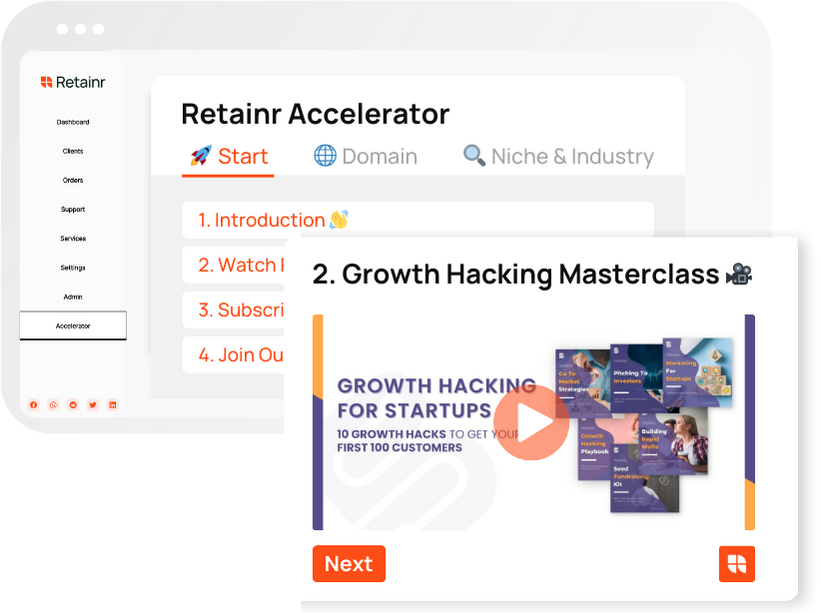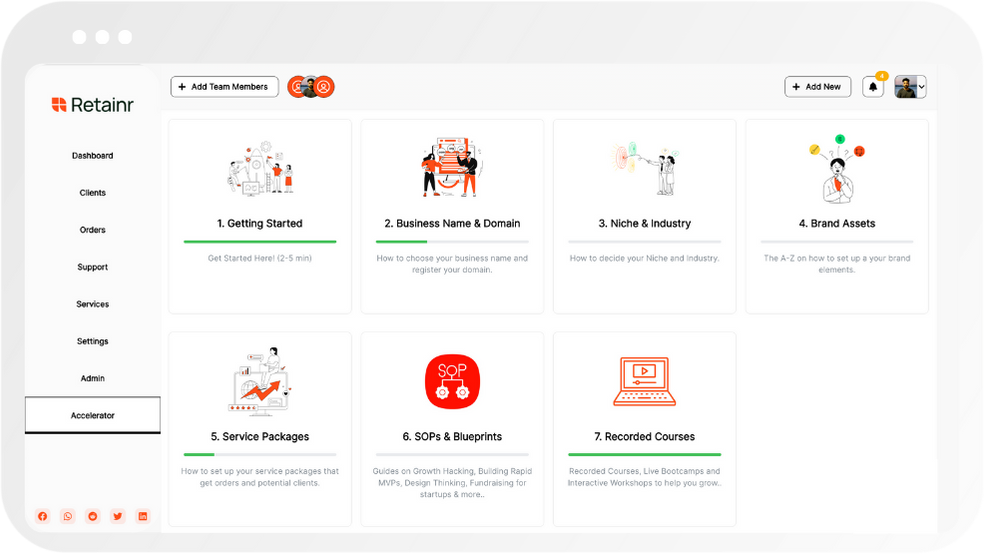
10 Key Features of a User-Friendly Interface You Should Know
Build with Retainr
Sell your products and services, manage clients, orders, payments, automate your client onboarding and management with your own branded web application.
Get Started1. What are the 10 key features of a user-friendly interface?
Understanding User-Friendly Interface Features
The goal of any software or product design is to make it as user-friendly as possible. A user-friendly interface can be the determining factor in a product's success or failure. As such, here are the 10 key features of a user-friendly interface:
- Simple and Clear Layout: A user-friendly interface will always have a simple, clean, and clear layout. It should not contain too much information, but rather only the essential elements.
- Consistency: It is important to maintain consistent design patterns throughout the interface. This helps users develop their understanding and proficiency over time.
- Responsiveness: The interface should respond quickly to user actions. Any delay or lag can lead to user frustration.
- Accessibility: Accessibility features should always be incorporated to cater for users with disabilities.
- Effective Navigation: A user-friendly interface will have easy-to-use and predictable navigation.
More Features of a User-Friendly Interface
Moving on, there are additional features that contribute towards the user interface's friendliness:
- Guidance: Good UI provides micro-interactions, hints, and suggestions to guide users on how to use the product or app.
- Compatibility: The interface should be designed to be compatible with multiple devices and operating systems.
- Appearance: The visual aesthetics of the interface can greatly affect the user's experience. Therefore, colors, fonts, and icons should be carefully chosen.
- Error Prevention: A good UI is designed in such a way that it not only helps users recover from mistakes but also prevents them in the first place.
- Information Architecture: Information should be organized in a meaningful and logical manner.
User-Friendly Interface Feature Summary
| Feature | Description |
|---|---|
| Simple and Clear Layout | Minimalistic design with only the essential elements |
| Consistency | Consistent design patterns throughout the UI. |
| Responsiveness | Quick response time to user interactions |
| Accessibility | Features catering to users with disabilities |
| Effective Navigation | Easy-to-use and predictable navigation |
| Guidance | Providing hints and suggestions for users |
| Compatibility | Designed for multiple devices and operating systems |
| Appearance | Appealing visual aesthetics influencing user experience |
| Error Prevention | Minimizing mistakes by thoughtful design |
| Information Architecture | Logical and meaningful organization of information |
2. How does simple navigation contribute to a user-friendly interface?
Importance of Simple Navigation
Simple navigation is vital for a user-friendly interface. It allows users to easily find information they need without wasting time searching. If a site's navigation is complicated or unclear, users are likely to leave and find a site that is easier to use. In contrast, a simple, intuitive navigation layout enables users to find what they're looking for quickly and easily, contributing to a positive user experience.
Key Elements of Simple Navigation
There are several key elements to creating simple navigation. These include:
- A clear, easy-to-find navigation bar or menu
- Breadcrumb trails that show users their path through the site
- A search bar for quick access to specific information
- Consistent navigation layout across all pages
- Links that accurately describe what users will find when they click
Impact of Simple Navigation on User Experience
| Features | Impact on User Experience |
|---|---|
| Clear Navigation Bar | Helps users find what they're looking for quickly |
| Breadcrumb Trails | Helps users understand their location within the site |
| Search Bar | Allows users to find specific information easily |
| Consistent Layout | Prevents user confusion while navigating through different pages |
| Descriptive Links | Helps users anticipate what they will find, enhancing usability |
3. How important is a clean layout in designing a user-friendly interface?
The Significance of a Clean Layout
One of the most critical aspects of user-friendly interface design is the layout. A clean, well-organized layout ensures easy navigation, efficient user interactions, and overall great user experience. This is why it's essential to understand the importance of a clean layout in UI/UX design.
- Improved Readability: A clean layout can significantly enhance readability. By avoiding clutter, the users can quickly identify critical elements and find what they need effortlessly. Clear contrast, proper spacing and use of headings and subheadings can guide the users' eye to important information.
- Crisp Navigation: Effective navigation is an integral part of a user-friendly interface. A clean layout simplifies navigation by enabling users to use the app/site without confusion, making the journey from start to finish smooth and effortless.
- Increased User Engagement: A clean layout promises optimal user engagement. A clutter-free interface that is easy on the eyes encourages users to spend more time on your application or website, and can effectually lead to higher conversion rates.
Designing a Clean Layout
Designing a clean layout for your interface involves well-planned strategies. Here's a simple guide on how to achieve it:
| Design Principle | Description |
|---|---|
| Utilize Whitespace | Whitespace or negative space is your best ally in achieving a clean layout. It helps highlight key elements, dividing your content and making it easier to understand. |
| Consistent Graphics & Typeface | Consistency in graphics and typeface contribute to a clean-looking interface. Avoid using excessive styles and keep your design elements simple and uniform. |
| Simple Navigation | Keep your navigation elements simple and intuitive. Avoid overwhelming your users with too many choices and prioritize clarity in your menu items. |
4. How does consistency in design elements enhance an interface's user-friendliness?
Significance of Consistency in Design Elements
Consistency plays an integral role in enhancing the user-friendliness of an interface. Through maintaining recurrent design elements, users do not have to learn new designs each time they navigate through your interface. This ultimately makes the user experience smooth, efficient and satisfying. Consistency can be achieved in various ways:
- Visual Consistency: This entails uniformity in colors, fonts, and overall aesthetics across different parts of your user interface.
- Functional Consistency: This ensures the same operations are performed in a similar manner, regardless of where they are in the user interface.
- External Consistency: This extends the uniformity beyond a single application to other products within the same family.
How Consistency Boosts User-Friendliness
Uniformity in design elements fosters familiarity and ease of use which are essential for user friendliness. Below are the ways consistency boosts the user friendliness:
| Principle | Explanation |
|---|---|
| Lower Learning Curve | Consistency in design elements reduces the time a user needs to familiarize themselves with the interface. |
| Increased Efficiency | Once users become familiar with repeated elements, they can navigate through the interface with ease and speed, thus increasing efficiency. |
| Enhanced User Satisfaction | Consistency in the user interface design results in a smoother and more enjoyable user experience, leading to higher user satisfaction. |
Establishing Consistency in Design Elements
Establishing consistency requires careful planning and execution. To ensure a consistent user interface design, consider the following:
- Design Guidelines: Implement and adhere to design guidelines to maintain aesthetics and functionality throughout the interface.
- Use of Grids: Grids provide a structure for placing design elements and help establish visual consistency.
- Component Library: Implement maintaining a component library, which includes reusable components, that aids in achieving functional consistency across the interface.
5. Why is mobile compatibility an essential feature of a user-friendly interface?
Crucial Role of Mobile Compatibility
In today's digital age, mobile compatibility plays a crucial role in a user-friendly interface. Given the increasing reliance on mobile devices, it is essential that a website or app should display correctly on any mobile device, irrespective of the screen size. When we speak about a user-friendly interface, this feature can't be left behind. A user-friendly website is one that adjusts itself automatically according to the device in use.
Significance of Mobile Compatibility
- User Engagement: Mobile compatibility attracts more users because it provides easy navigation and easy reading with a minimum need for resizing, panning, and scrolling. This increases user engagement.
- Brand Reputation: Non-compatible mobile interfaces may frustrate users and may ruin a brand's reputation. On the other hand, a mobile-compatible interface leaves a good impression and can even boost a brand's reputation.
- Increase Traffic: As the majority of traffic comes from mobile device users, mobile compatibility can significantly boost your site's traffic.
- Optimized for SEO: Mobile-compatible websites are also optimized better for SEO, as Google rewards sites that are mobile-friendly.
Table for Mobile Compatibility Features
| Features | Description |
|---|---|
| Responsive Design | The layout adjusts according to the screen size. |
| Fast Load Times | The website loads quickly on mobile devices. |
| Easy Navigation | Users can easily navigate the site. |
| Legible Text | Text on the website is easily readable without zooming. |
| Accessible Links | Links and buttons are adequately sized and easy to click on. |
6. Can you explain the role of intuitive design in a user-friendly interface?
The Role of Intuitive Design in a User-Friendly Interface
Intuitive design plays a crucial role in crafting a user-friendly interface. Its primary focus is to provide users with an instinctive layout where they can seamlessly navigate, interact, and complete tasks. It's not only about making the interface pleasing to the eye, but also making it intuitive to everyone, irrespective of their age, tech proficiency, or cultural background.
The fundamental characteristics of an intuitive design include:
- Consistency: Similar functions should be represented with the same icons throughout the interface. This helps users anticipate how an unfamiliar element might work based on their experiences with similar functions.
- Simplicity: An interface cluttered with too many functions and options can confuse users. It is vital to keep things visually simple and straightforward.
- Efficiency: Anything more than 3-clicks to reach a task is counterintuitive. Good design spares users from performing unnecessary actions.
- Feedback: Instantaneous and clear feedback on user actions, such as spinning loaders and progress bars, ensures users that their actions were received by the system and something is happening.
| Feature of Intuitive Design | Description |
|---|---|
| Consistency | Represents similar functions with the same icons. |
| Simplicity | Keeps the UI visually simple and straightforward. |
| Efficiency | Avoids unnecessary user actions and operations. |
| Feedback | Provides clear and immediate feedback on user actions. |
Overall, an intuitive design should allow users to understand the interface's inner workings without any explanation or extensive mentoring. Therefore, pursuing insights from user testing, analytics, and feedback comes critical, transforming an ordinary user interface into a top-notch, user-friendly one.
7. How does error prevention or easy recovery improve the user interface experience?
Error Prevention and User Interface Experience
Error prevention should be among the key features when designing user interfaces because nobody likes to make mistakes. When users make errors, productivity decreases due to repeated trial-and-error efforts, frustration and disappointment increase, and the initial trust in the service or product is eroded. By integrating error prevention approaches, designers can create an efficient, stress-free and user-centric experience.
- Form validation: This prevents errors by checking the user's data input before it is processed. For example, if a mandatory input field is left unanswered, a warning message could appear to prompt the user.
- Confirmation alerts: For critical actions, such as deleting an item or a file, a confirmation alert safeguards the user from accidental clicks and unwanted loss of content.
- Instructions and help: Providing field instructions and tooltips can guide users while performing tasks and make navigation easier, resulting in fewer errors.
Easy Recovery and User Interface Experience
No matter how well an interface is designed, users will inevitably make errors. It's therefore crucial that the interface allows users to recover from errors as effortlessly as possible, without losing work or causing frustration. Implementing simple and clear recovery paths will enhance the user experience, as shown in the following examples:
| Action | Recovery Option |
|---|---|
| Mistakenly sending an email | Offer an 'undo send' option which holds the mail for few seconds before actually sending it. |
| Deleting a file | Move deleted files to a 'trash' or 'recycle bin' where they can be recovered if deleted by mistake. |
| Entered wrong information | Provide an 'edit' option to allow users to correct their mistakes easily. |
8. Why is it important to consider load times when designing a user-friendly interface?
Understand the Impact of Load Times on User Experiences
Load times play a critical role in determining the user-friendliness of an interface. The highly digital and fast-paced world today has left users with little patience for slow-loading applications or websites. It is found that a one-second delay in page load time results in a 7% loss in conversions, 11% fewer page views, and a 16% decrease in customer satisfaction. Therefore, prioritizing minimized load times in the design process is a crucial aspect in creating a user-friendly interface.
Load Times And SEO Performance
- Ranking factor: Search engines like Google consider page load speed as one of the ranking factors. Faster loading websites are rewarded with higher search engine result page (SERP) rankings.
- Bounce rate: Slow load times are closely tied to higher bounce rates, i.e., users abandoning your website before it even finishes loading, which can negatively impact your SEO performance.
- Organic traffic: Swiftly loading websites are likely to entice more organic traffic, generate higher engagement rates, and score better conversions and revenue.
Key Aspects to Consider for Reducing Load Times
| Aspect | Description |
|---|---|
| Optimized Images | Huge, unoptimized images are often the primary cause for slow load times. Ensure your images are compressed and optimized for the web. |
| Clean Code | Proper coding practices, like removing unnecessary characters, spaces, and lines, contributes to faster loading times. |
| Proper Use Of Cache | Utilizing caching mechanisms can significantly reduce load times, by storing certain parts of your web pages in the user's browser so they don't need to be reloaded every time. |
9. How does accessible design make an interface more user-friendly?
Understanding Accessible Design
Accessible design is a design process in which the needs of people with disabilities are specifically considered. In terms of user interface, it involves designing in a way such that everyone, including those with disabilities, can easily understand, navigate, and interact with a website or application. The following aspects make the design more user-friendly:
- Text alternatives: Providing text descriptions for non-text content like images, animations, and videos make content accessible to people with visual impairments.
- Color contrast: Ensuring sufficient contrast between foreground and background colors helps users who have color blindness or low-vision see and use your interface.
- Keyboard accessibility: Designing interactions where users don't have to rely on a mouse and can access all functionality through a keyboard helps people with motor disabilities.
The Importance of Accessible Design
Why is accessible design important? Not only does it enhance the user experience for all visitors, but it's often required by law. A user-friendly interface allows more people to use your site or app, boosting your potential audience or customer base. Here's a simple way to compare an accessible design with a non-accessible one:
| Accessible Design | Non-Accessible Design |
|---|---|
| Text alternatives for non-text content | No alternatives, relying on visuals |
| Sufficient color contrast | Insufficient contrast, hard to see |
| Functionality accessible via a keyboard | Reliance on mouse, excluding some users |
Conclusion
By understanding and implementing accessible design, you not only make your interface more user-friendly but also inclusive to all. This results in a wider audience reach, improved user experience, and enhanced usability. Accessible design is therefore not an option but an essential feature of any successful user interface.
10. Why is clear communication an essential feature of a user-friendly interface?
Importance of Clear Communication in a User-friendly Interface
Clear communication is an integral part of any user-friendly interface. It entails concise wording, clear instructions, and straightforward feedback to the users. Here’s why clear communication is considered a key feature in user interface design:
- User Guidance: A well-communicated interface guides users seamlessly through tasks. It offers a clear understanding of their position in the system and what actions are required to accomplish their goals.
- Error Prevention: Clear instructions and messages can preempt mistakes by informing users about the repercussions of their actions beforehand.
- Maintaining User Trust: Transparency in design through clear communication enhances user trust. For instance, unambiguous terms and conditions, privacy policies, and data usage statements reassure users about their data security.
How Clear Communication Impact User Experience
The impacts of clear communication on user experience can be evaluated through certain metrics, which can be tabulated as follows:
| Metrics | Description |
|---|---|
| User Errors | A decrease in user errors indicates improved understanding, thanks to clear instructions and feedback. |
| Completion Time | A reduction in task completion time signifies easy navigation and lucid understanding due to efficient communication. |
| Satisfaction Ratings | High satisfaction ratings reflect successful communication that has contributed to a pleasant user experience. |
Conclusion
To sum up, a user-friendly interface pays meticulous attention to clear communication. An unambiguous system with well-defined instructions, error messages, and feedback can accomplish user goals efficiently. In contrast, ambiguous messages can confuse and frustrate users, leading to task abandonment or errors. Thus, clear communication significantly levels up the usability, efficiency, and overall user satisfaction, making it an essential feature of an engaging and user-friendly interface.
Conclusion
Key Features of User-Friendly Interfaces
A user-friendly interface can mean the difference between a frustrating or delightful user experience. This blog explores ten critical features of user-friendly interfaces, employing elements such as simplicity, consistency, and intuitive design to deliver functionalities that cater to users’ needs effectively.
Simplicity Matters
Users should be able to navigate through the software seamlessly with an interface that is clear, uncluttered, and not overwhelmed with unnecessary options.
Consistency in Design
Maintaining uniformity in colors, fonts, and layout across various screens ensure a comfortable and continuous user experience.
Responsive Interaction
The interface should respond promptly to user inputs, such as click, scroll, or other gestures, creating a smooth interaction.
Intuitive Navigation
Navigation should be straightforward and instinctive, allowing users to find what they are looking for with minimum effort.
Clarity and Visibility
Every element on the interface should be clearly visible and understandable for users to make informed decisions.
Helpful Error Handling
Errors are inevitable, but the software should handle them gracefully, providing effective solutions rather than complicated error messages.
Compatibility
The software must be compatible across various devices and platforms, ensuring a consistent experience for all users.
Personalization
Personalization enhances the user experience, allowing users to modify the settings to suit their unique needs and preferences.
Efficient Loading Times
User satisfaction can sharply decline with slow-loading interfaces. Hence, ensuring efficient loading speeds is vital.
Accessibility
Digital accessibility ensures that the software can be used by all users irrespective of any physical or cognitive disabilities.
Retainr.io: Making Interfaces User-Friendly
Applying these features into practical use, Retainr.io provides a white-label software that emphasizes a user-friendly interface, dwells on simplicity, and applies consistent design principles. This powerful platform enables businesses to sell, manage clients, orders, and payments all through their brand's app. It achieves a harmonious balance of function & design, with its fast loading times, efficient navigation, and responsive interaction. Explore new possibilities in user-centric design with Retainr.io.
Boost Your Agency Growth
with Retainr Accelerator
Uncover secrets, strategies, and exclusive blueprints to take your agency's growth to the next level — from marketing insights to effective presentations and leveraging technology.

SOPs, Cheatsheets & Blueprints
Leverage 50+ SOPs (valued over $10K) offering practical guides, scripts, tools, hacks, templates, and cheat sheets to fast-track your startup's growth.
Connect with fellow entrepreneurs, share experiences, and get expert insights within our exclusive Facebook community.
.jpg)

Join a thriving community of growth hackers. Network, collaborate, and learn from like-minded entrepreneurs on a lifelong journey to success.

Gain expertise with recorded Courses, Live Bootcamps and interactive Workshops on topics like growth hacking, copywriting, no-code funnel building, performance marketing and more, taught by seasoned coaches & industry experts.

.jpg)

.jpeg)


